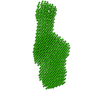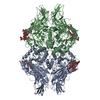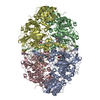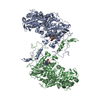[English] 日本語
 Yorodumi
Yorodumi- SASDBW4: Albumen gland precursor of ovorubin (lipoglycocarotenoprotein agP... -
+ Open data
Open data
- Basic information
Basic information
| Entry | Database: SASBDB / ID: SASDBW4 |
|---|---|
 Sample Sample | Albumen gland precursor of ovorubin (lipoglycocarotenoprotein agPcOvo: an oligomeric protein)
|
| Function / homology | Perivitellin ovorubin-2 / Perivitellin ovorubin-1 / Perivitellin ovorubin-3 Function and homology information Function and homology information |
| Biological species |  Pomacea canaliculata (invertebrata) Pomacea canaliculata (invertebrata) |
 Citation Citation |  Journal: Physiol Biochem Zool / Year: 2017 Journal: Physiol Biochem Zool / Year: 2017Title: Apple Snail Perivitellin Precursor Properties Help Explain Predators' Feeding Behavior. Authors: María Pilar Cadierno / Marcos Sebastián Dreon / Horacio Heras /  Abstract: In contrast with vitellogenin maturation, it is unknown whether gastropod perivitellin precursors are subject to large structural changes. The gastropod reproductive tract includes an accessory ...In contrast with vitellogenin maturation, it is unknown whether gastropod perivitellin precursors are subject to large structural changes. The gastropod reproductive tract includes an accessory organ, the albumen gland (AG), that produces and secretes perivitelline fluid. In the apple snail Pomacea canaliculata, the large, reddish-pink AG provides eggs with perivitellins that are defensive against predators. Although the AG makes a considerable contribution to apple snail biomass, field observations indicate that it is rejected by avian and mammalian predators, although the underlying reason remains unknown. By analyzing the structure-function properties of P. canaliculata perivitellin precursors, we provide insight into perivitellin maturation and its relationship with apple snail predator feeding behavior. Structural analysis using small-angle X-ray scattering, absorption and fluorescence spectroscopy, circular dichroism, electrophoresis, chromatography, and partial proteolysis showed that the size, shape, and structure of perivitellin precursors resemble those of egg mature forms. Functional analysis indicates that the precursors of the defensive perivitellins ovorubin (PcOvo) and perivitellin-2 (PcPV2) are highly stable and antinutritive, withstanding proteinase digestion and displaying structural stability of their quaternary structure under a wide pH range (4.0-10.0). Furthermore, AG extracts limit a predator's ability to digest nutrients and are toxic to mice (median lethal concentration 96 h after administration: 5.9 mg/kg). Treated mice displayed neurologic signs similar to those produced by egg PcPV2. Results indicate that apple snails store active precursors of egg proteins inside the AG, providing evidence that gastropod perivitellin precursors do not experience the large structural processing of invertebrate vitellogenin maturation. These defensive proteins provide the apple snail AG with neurotoxic, antinutritive, and antidigestive activity, a likely explanation for the predators' feeding behavior. |
 Contact author Contact author |
|
- Structure visualization
Structure visualization
| Structure viewer | Molecule:  Molmil Molmil Jmol/JSmol Jmol/JSmol |
|---|
- Downloads & links
Downloads & links
-Models
| Model #537 |  Type: dummy / Software: (r3695) / Radius of dummy atoms: 3.10 A / Chi-square value: 2.692881 / P-value: 0.000024  Search similar-shape structures of this assembly by Omokage search (details) Search similar-shape structures of this assembly by Omokage search (details) |
|---|---|
| Model #538 |  Type: dummy / Software: (r3695) / Radius of dummy atoms: 3.10 A / Chi-square value: 2.640625 / P-value: 0.000024  Search similar-shape structures of this assembly by Omokage search (details) Search similar-shape structures of this assembly by Omokage search (details) |
- Sample
Sample
 Sample Sample | Name: Albumen gland precursor of ovorubin (lipoglycocarotenoprotein agPcOvo: an oligomeric protein) Specimen concentration: 1.04-4.16 / Entity id: 343 / 344 / 345 |
|---|---|
| Buffer | Name: 20 mM Tris-HCl / Concentration: 20.00 mM / pH: 8.5 |
| Entity #343 | Name: Ovo1 / Type: protein / Description: Perivitellin ovorubin-1 / Formula weight: 22.384 / Source: Pomacea canaliculata / References: UniProt: J7I2T6 Sequence: MFVATSLLLA IATLVVRASP HNYLIMDIEP PKSVSERDIL NLLSPLQVKH SFRVTGSTRL LIVIRLDAQS YEKLDEITVP GKVEVIPAVN MADTMERCGV SWPRVELTDD NVTLFESEST LTDVTKEQLK AMLIGYGEHM SGLLQAHRFE YYQAAGATPH RHFVFVNSVP ...Sequence: MFVATSLLLA IATLVVRASP HNYLIMDIEP PKSVSERDIL NLLSPLQVKH SFRVTGSTRL LIVIRLDAQS YEKLDEITVP GKVEVIPAVN MADTMERCGV SWPRVELTDD NVTLFESEST LTDVTKEQLK AMLIGYGEHM SGLLQAHRFE YYQAAGATPH RHFVFVNSVP DEIEVFGREG VDIWGGPGEF VVKPQYVTRI |
| Entity #344 | Name: Ovo2 / Type: protein / Description: Perivitellin ovorubin-2 / Formula weight: 23.801 / Source: Pomacea canaliculata / References: UniProt: J7HZ90 Sequence: MAEHRIPVLL LLVVVAASSL AQQIPLQKHY IIYEVRNIEK TPEEVKEEMK DTDILYSFKA LGAPSYHIVV EVNPRNMRKL EEVELKGKIR MVPVVNMVDV AETLGVSWPR SGARLLDVNL TLIERTLNQE GLTSQESEAH LKGFMEELKD RLQQYNYQAF FTIGASPPKM ...Sequence: MAEHRIPVLL LLVVVAASSL AQQIPLQKHY IIYEVRNIEK TPEEVKEEMK DTDILYSFKA LGAPSYHIVV EVNPRNMRKL EEVELKGKIR MVPVVNMVDV AETLGVSWPR SGARLLDVNL TLIERTLNQE GLTSQESEAH LKGFMEELKD RLQQYNYQAF FTIGASPPKM YIYINIPYEE VDKFACIGIN QFGGPAAVNT TVSFISSFPK |
| Entity #345 | Name: Ovo3 / Type: protein / Description: Perivitellin ovorubin-3 / Formula weight: 34.957 / Source: Pomacea canaliculata / References: UniProt: J7I5Z5 Sequence: MYALAIALLA FSTFVSNAFA NKEYLLLDIR DATTSEIISA LRDVEIELKV KAKGIARHLI VVKQNDANLQ KLGEIDIPGR SCSTPVEDLD NLMEDIGISW PRNELTSVNV TLFERTLDLK DKTMEQFWSE AKAYGQLVKP VLSSFTYRAF KANGAYPPKV YFFVNLPREN ...Sequence: MYALAIALLA FSTFVSNAFA NKEYLLLDIR DATTSEIISA LRDVEIELKV KAKGIARHLI VVKQNDANLQ KLGEIDIPGR SCSTPVEDLD NLMEDIGISW PRNELTSVNV TLFERTLDLK DKTMEQFWSE AKAYGQLVKP VLSSFTYRAF KANGAYPPKV YFFVNLPREN LNDASSKGID IFGGPGKART TVQYISVCVA VSHSTFSCRQ SVGDMKCMFQ QPPVPARSSG RPGRYDNQVR HGVRIAAPVM ENFPNYILLS KGTFPPKSRF RSNLWGLVNG SRRISRRGKP LLHNKHPNHY QMELKYTIAT H |
-Experimental information
| Beam | Instrument name: Brazilian Synchrotron Light Laboratory SAXS2 Beamline City: Campinas / 国: Brazil  / Type of source: X-ray synchrotron / Type of source: X-ray synchrotron | |||||||||||||||||||||||||||||||||
|---|---|---|---|---|---|---|---|---|---|---|---|---|---|---|---|---|---|---|---|---|---|---|---|---|---|---|---|---|---|---|---|---|---|---|
| Detector | Name: MAR 165 CCD | |||||||||||||||||||||||||||||||||
| Scan |
| |||||||||||||||||||||||||||||||||
| Distance distribution function P(R) |
| |||||||||||||||||||||||||||||||||
| Result | Comments: agPcOvo is an oligomeric lipoglycocarotenoprotein isolated from the albumen gland of P. canaliculata that consists of different perivitellin ovorubin subunits (Ovo1-3) that form a complex ...Comments: agPcOvo is an oligomeric lipoglycocarotenoprotein isolated from the albumen gland of P. canaliculata that consists of different perivitellin ovorubin subunits (Ovo1-3) that form a complex with a molecular weight of 300 kDa.
|
 Movie
Movie Controller
Controller

 SASDBW4
SASDBW4







